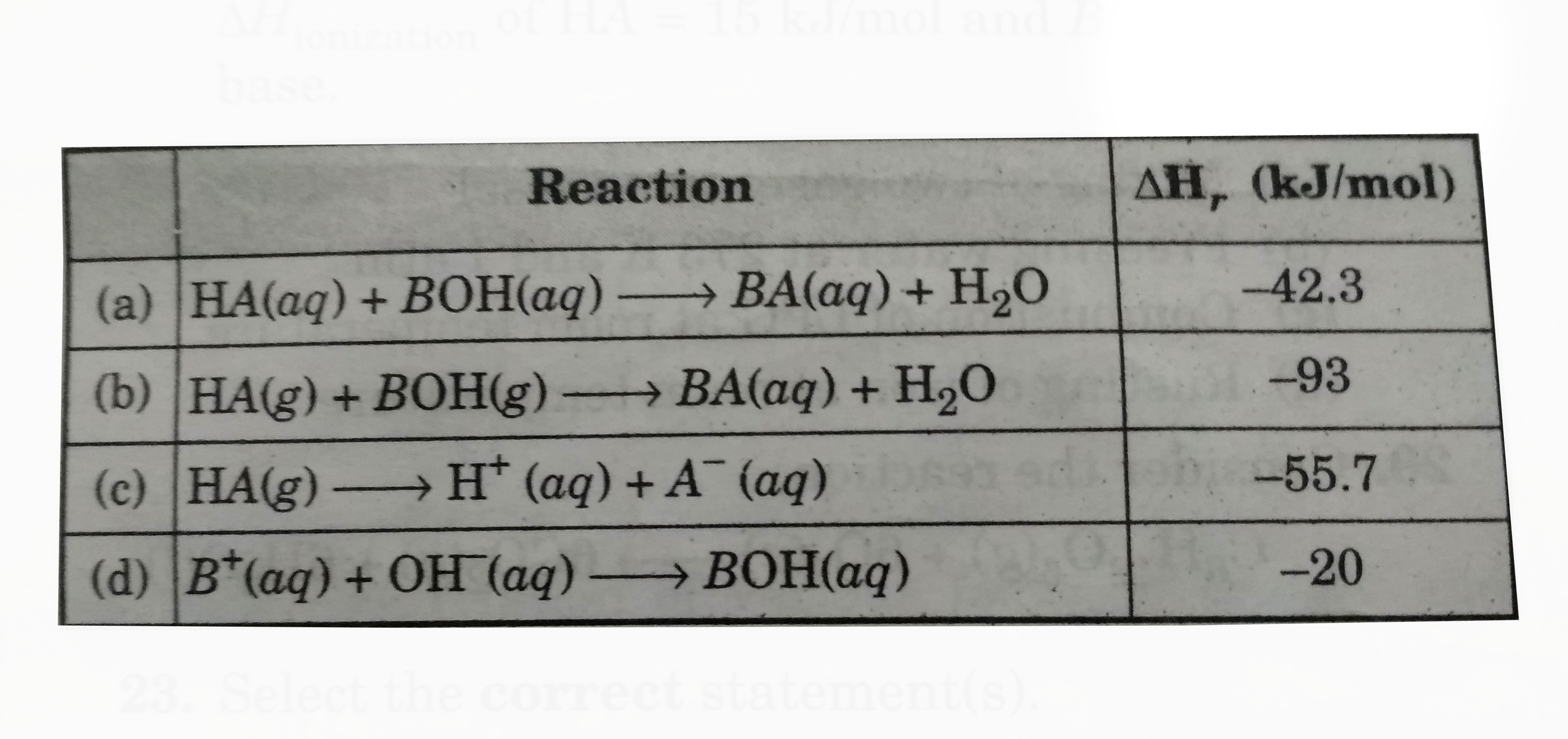Calculate the enthalpy change for the given reaction from data provided (kJ/mole)
HA(g)+B(g)−−→AHB(s)(weak acid)(weak acid)(Salt)
ΔHneutralization{HA(aq)[at infinite dilution]/B(aq)[at infinite dilution]}=−40 kJ/mole
ΔHsolution[HA(g)]=−10 kJ/mole{at infinite dilution}ΔHsolution[B(g)]=−5 kJ/mole{at infinite dilution}ΔHsolution[HAB(s)]=+8 kJ/mole{at infinite dilution}
−36
−63
−45
−37
The correct Answer is:B
HA(g)+ B(g)ΔH−−−−−→ AHB(s)+nH2O↓ΔH1+nH2O↓ΔH2+nH2O↓ΔH4 HA(aq)+ B(aq)ΔH3−−−−−→ A−(aq)+B+(aq)
ΔH=ΔH1+ΔH2+ΔH3−ΔH4
=−10−5−8−40=−63 kJ/mole
Topper's Solved these Questions
- THERMOCHEMISTRYBOOK - BANSALCHAPTER - THERMOCHEMISTRYEXERCISE - Exercise
8 Videos
- THERMOCHEMISTRYBOOK - BANSALCHAPTER - THERMOCHEMISTRYEXERCISE - Exercise 1
16 Videos
- THERMOCHEMISTRYBOOK - BANSALCHAPTER - THERMOCHEMISTRYEXERCISE - Exercise 4
15 Videos
- TEST PAPERSBOOK - BANSALCHAPTER - TEST PAPERSEXERCISE - PHYSICS
1 Videos
- THERMODYNAMICSBOOK - BANSALCHAPTER - THERMODYNAMICSEXERCISE - Exercise 3
43 Videos
Similar Questions
From the following date , mark the opation(s) where ΔH is correctly written for the given reaction .
Given: H+(aq)+OH−(aq)→H2O(l),
ΔH=−57.3kJ
ΔHsolutionHA(g)=−70.7kJmole
ΔHsolutionBOH(g)=−20kJmole
ΔHionzatoin of HA=15kJ/mole and BOH is a strong base.

View SolutionFrom the following date , mark the opation(s) where ΔH is correctly written for the given reaction .
Given: H+(aq)+OH−(aq)→H2O(l),
ΔH=−57.3kJ
ΔHsolutionHA(g)=−70.7kJmole
ΔHsolutionBOH(g)=−20kJmole
ΔHionzatoin of HA=15kJ/mole and BOH is a strong base.

View Solution
Knowledge Check
Calculate the ethanly change for the given reaction from data provided (KJ/mole)
HA(g)+B(g)−−→AHB(s)(weak acid)(Weak base)(Salt)
ΔHneutralization {HA(aq)[at infinte dilution ]/B(aq)
[at infinite dilution ]=−40kJ/mole
ΔHsolution [HA(aq)]=−10kJ/mole{at infinite dilution }
ΔHsoltuion[B(g)=−5KJ/mole{at infinite dilution}
ΔHsolution [HAB(s)]=+8KJ/mole
{at infinite dilution}A−36B−63C−45D−37From the following data, mark the option (s) where ΔH is correctly written for the given reaction. Given:
H+(aq)+OH−(aq)→H2O(l) ΔH=−57.3kJ
ΔHsolution of HA(g)=−70.7 kJ/mol
Δsolution of BOH(g)=20 kJ/mol
ΔHionization of HA=15 kJ/mol & BOH is a strong baseAReactionΔHR (kJ/mole)HA(aq)+BOH(aq)→BA(aq)+H2O−42.3BReactionΔHR (kJ/mole)HA(g)+BOH(g)→BA(aq)+H2O−93CReactionΔHR (kJ/mole)HA(g)→H+(aq)+A−(aq)−55.7DReactionΔHR (kJ/mole)B+(aq)+OH−(aq)→BOH(aq)−20Calculate bond energy of X−X bond from the following data.

ΔHfofX(g)=+300kJ/mole
 A400 kJB200 kJC100 kJD150 kJ
A400 kJB200 kJC100 kJD150 kJ
Calculate the enthalpy change of 1 mole of reaction
Na(s)+12Br2(g)→NaBr(s) in kcal
Given : ΔHsub(Na)=137kJmole−1,ΔHbond dissociation(Br2(g))=144kJmole−1
ΔH1 st ionisation(Na(g)=496kJmole−1,ΔH1stelectron affinity(Br(g)=−325kJmole−1
ΔHLattice energy(NaBr)=+742
View SolutionFind the bond enthalpy (in kJ/mol) of one "three centre two electron bond" in B2H6{B−H−B→2B(g)+H(g)} from the given data.
ΔH∘f[BH3(g)]=100 kJ/moleΔH∘f[B2H6(g)]=36 kJ/moleΔHatm[B(s)]=565 kJ/moleΔHatm=[H2(g)]=218 kJ/mole
View SolutionCalculate the strength of H-bond between F−(g) and CH3COOH(g) from the given data.
ΔHsolution[KF.CH3COOH(s)] in glacial acetic acid=−3 kJ/moleΔHsolution[KF(s)] in glacial acetic acid=+35 kJ/moleLattice Enthalpy KF(s)=+797 kJ/moleLattice enthalpy of KF.CH3COOH(s)=+734 kJ/moleΔHvaporization[CH3COOH(l)]=+21 kJ/mole
View SolutionCalculate the temperature above which the given reaction become spontaneous.
C(s)+H2O(g)→CO(g)+H2(g)
ΔH∘=+131.3KJ/mole ,
ΔS∘=+0.1336KJ/moleK
View SolutionCalculate the temperature above which the given reaction become spontaneous.
C(s)+H2O(g)→CO(g)+H2(g)
ΔH∘=+131.3KJ/mole ,
ΔS∘=+0.1336KJ/moleK
View Solution
